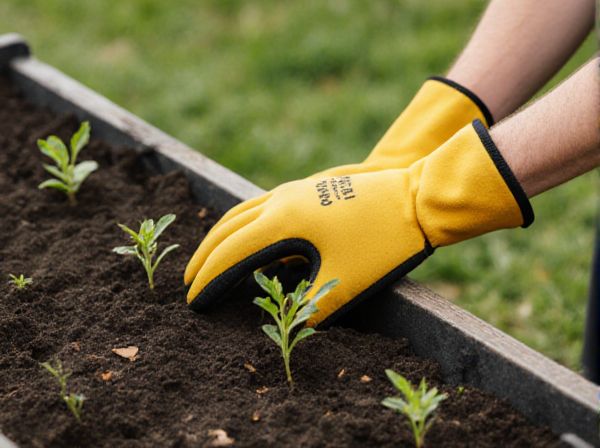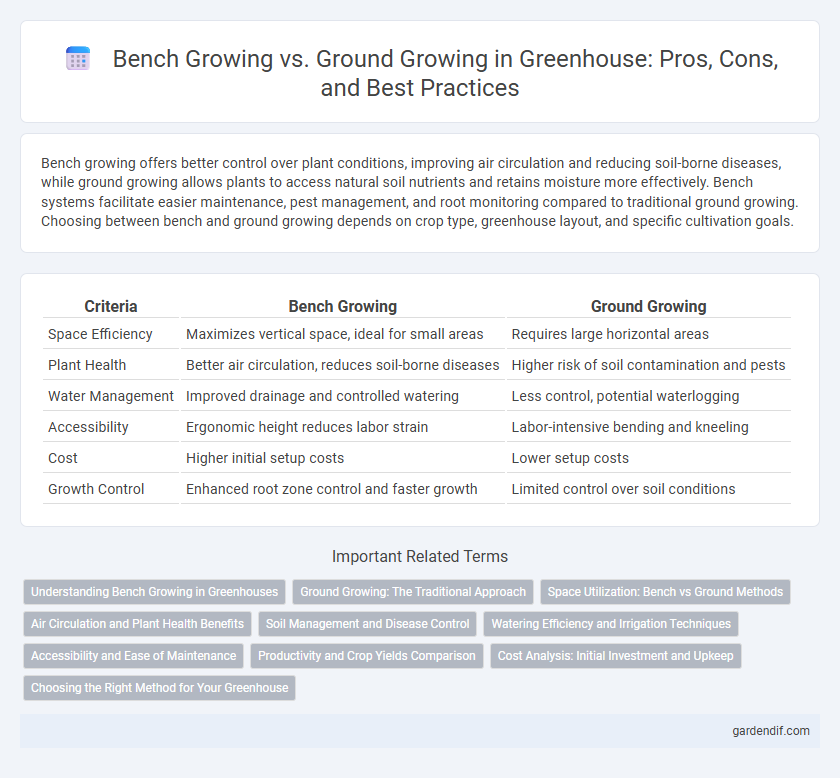
Bench Growing vs Ground Growing Illustration
Bench growing offers better control over plant conditions, improving air circulation and reducing soil-borne diseases, while ground growing allows plants to access natural soil nutrients and retains moisture more effectively. Bench systems facilitate easier maintenance, pest management, and root monitoring compared to traditional ground growing. Choosing between bench and ground growing depends on crop type, greenhouse layout, and specific cultivation goals.
Table of Comparison
| Criteria | Bench Growing | Ground Growing |
|---|---|---|
| Space Efficiency | Maximizes vertical space, ideal for small areas | Requires large horizontal areas |
| Plant Health | Better air circulation, reduces soil-borne diseases | Higher risk of soil contamination and pests |
| Water Management | Improved drainage and controlled watering | Less control, potential waterlogging |
| Accessibility | Ergonomic height reduces labor strain | Labor-intensive bending and kneeling |
| Cost | Higher initial setup costs | Lower setup costs |
| Growth Control | Enhanced root zone control and faster growth | Limited control over soil conditions |
Understanding Bench Growing in Greenhouses
Bench growing in greenhouses involves cultivating plants on elevated platforms, which enhances air circulation, improves drainage, and facilitates better pest management compared to ground growing. This method optimizes space utilization and allows for precise control over soil conditions and watering, contributing to healthier plant development and higher yields. Growers benefit from easier access to plants for maintenance and harvesting, boosting overall greenhouse efficiency and productivity.
Ground Growing: The Traditional Approach
Ground growing remains the traditional approach in greenhouse horticulture, offering plants natural soil nutrients and microbial interactions that enhance root development and overall plant health. This method leverages the earth's inherent temperature regulation and moisture retention properties, reducing the need for artificial interventions. While bench growing provides easier access and space optimization, ground growing excels in promoting robust plant growth and resilience through direct soil exposure.
Space Utilization: Bench vs Ground Methods
Bench growing in greenhouses maximizes vertical space utilization by elevating plants, allowing for increased crop density and easier access for maintenance, which reduces labor costs. Ground growing occupies horizontal floor space, often limiting plant spacing due to accessibility and soil health considerations, resulting in lower overall planting density. Optimizing space through bench systems enhances airflow and light distribution, promoting healthier plant growth and higher yields compared to traditional ground methods.
Air Circulation and Plant Health Benefits
Bench growing in greenhouses enhances air circulation by elevating plants above the ground, reducing the risk of fungal diseases caused by stagnant moisture. Improved airflow around bench-grown plants supports healthier foliage and root development compared to ground growing, where soil-borne pathogens and humidity accumulation are more prevalent. Optimized ventilation in bench systems promotes stronger plants, higher yields, and reduced chemical intervention for pest and disease control.
Soil Management and Disease Control
Bench growing allows precise soil management through controlled media composition and drainage, reducing pathogen buildup compared to ground growing, which relies on native soil with variable conditions. Ground growing often faces higher risks of soil-borne diseases due to inconsistent soil structure and moisture levels, necessitating crop rotation and soil fumigation techniques. Implementing sterilized substrates in bench systems enhances disease control by minimizing exposure to soil pathogens common in field environments.
Watering Efficiency and Irrigation Techniques
Bench growing systems in greenhouses enhance watering efficiency by enabling precise irrigation control, reducing water waste through targeted drip or ebb-and-flow techniques. Ground growing often relies on traditional sprinkler or furrow irrigation, which tends to consume more water and increase evaporation losses. Employing automated drip irrigation in benches maximizes water use efficiency and promotes healthier root development compared to ground-based methods.
Accessibility and Ease of Maintenance
Bench growing in greenhouses offers elevated plant beds that improve accessibility by reducing the need to bend or kneel, making planting, watering, and harvesting easier for gardeners. Ground growing requires more physical effort as plants are at soil level, which can lead to increased strain and difficulty during routine maintenance. Elevated benches also facilitate better airflow and pest control, enhancing overall plant care efficiency.
Productivity and Crop Yields Comparison
Bench growing in greenhouses enhances productivity by maximizing space utilization and improving crop yields through controlled environmental conditions. Ground growing often faces challenges like soil-borne diseases and uneven nutrient distribution, which can reduce overall yield efficiency. Optimizing bench systems promotes faster growth cycles and higher density planting, leading to superior crop output compared to traditional ground methods.
Cost Analysis: Initial Investment and Upkeep
Bench growing in greenhouses generally requires a higher initial investment due to the cost of constructing benches and supporting structures, but it offers lower ongoing maintenance costs by improving plant accessibility and reducing soil-borne diseases. Ground growing has a lower upfront cost since it utilizes the existing soil structure, but it often incurs higher upkeep expenses related to soil management, pest control, and irrigation system maintenance. Analyzing total cost of ownership reveals bench systems offer long-term savings for high-density crops, while ground growing suits operations with limited initial capital and lower production intensity.
Choosing the Right Method for Your Greenhouse
Choosing between bench growing and ground growing in a greenhouse depends on factors like plant type, space optimization, and environmental control. Bench growing enhances air circulation, reduces pest exposure, and facilitates easier maintenance, making it ideal for seedlings and delicate plants. Ground growing suits larger crops with extensive root systems, offering natural soil conditions and moisture retention within controlled greenhouse settings.
Bench Growing vs Ground Growing Infographic

 gardendif.com
gardendif.com